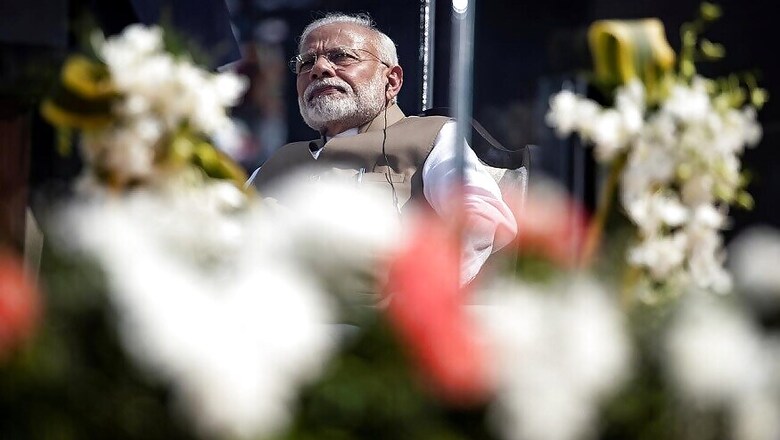
views
History is merely a list of surprises, said Kurt Vonnegut. If so, the first year of Modi 2.0 sprung more than its fair share. It began with a historic win, lurched through a series of misadventures and ended in a historic crisis. The Modi charisma survived it all.
In May 2019, a triumphant march to power for Narendra Modi. In May 2020, a gruelling march home for migrant workers. And in between, a rapid descent of Modi's graph, from the high point of the “100-day plan” with its 167 big bang ideas, to rioting in the streets of the capital.
For Modi's legions, he is living proof of the Great Man Theory, the leader who arises when society needs him most. But as the year progressed, the man who had won the nation's confidence, appeared to be losing his own. A series of unforced errors hinted that the great leader's grip on governance had slackened.
Modi 2.0 began with home minister Amit Shah's deftly-manoeuvred abrogation of Article 370, removing a vexatious thorn in the RSS' side with the tacit assent of the majority. Public approval remained high as the first 100 days came to a close, and higher still, when the PM embraced US President Donald Trump at the rambunctious 'Howdy Modi' gala in Texas.
Shah's overreach, in the form of the Citizenship Amendment Act (CAA), triggered a slide. Sources say that he overrode the PM's reservations and rapidly steered the law through Parliament. The CAA’s constitutionality may be undecided, but it was strategically flawed. Poor timing and an unfortunate association with the National Register of Citizens (NRC) made it a cause celebre. Long-simmering resentments of interest groups found a platform.
Violence erupted in universities, the last bastion of the Left. Belying Shah's reputation as a master strategist, the Delhi Police responded to the students' protests against CAA in a ham-handed fashion, putting the Centre on the defensive. The Modi government became an object of global censure, accused of suppressing civic freedoms.
Simultaneously, the little-known locality of Shaheen Bagh, scene of a 'spontaneous' protest designed for maximum visibility and appeal to liberal sentiments, became emblematic of minority rights. Rather than shut it down, the BJP chose to make it the focus of its campaign for the Delhi assembly elections.
Shah's decision to front the campaign personally was as mystifying as its provocative nature, pegged on an uber-nationalist narrative built around the CAA-NRC. To no one’s surprise, the Aam Aadmi Party swept the Delhi elections, with the BJP coming a poor second.
Error was piled upon error and a free run given to a Johnny-come-lately BJP leader who blatantly provoked anti-CAA protestors. The first stone was reportedly cast by infuriated protestors, resulting in a fearful and disproportionate backlash. The riots lasted for three days and left 53 dead.
By this time, the global media had other things to worry about: Italy had reported its 400th case of coronavirus and the US had announced its first death from the virus.
The capricious gods who had smiled on Modi, now tasked him with a Herculean labour: locking down a nation of 1.3 billion people. By all accounts, he took the decision with deep reluctance. The economy juddered to an abrupt halt on March 25.
In subsequent weeks, heads of government all over the world, including the UK, France and the US, would be castigated on social media for missteps: delay in imposing curbs on public mobility, limited availability of Personal Protective Equipment (PPE) and insufficient testing. Even in Germany, lauded abroad for effective containment, the government faced flak at home. Modi came in for his share of brickbats.
The Tablighi Jamaat disaster caught the Home ministry flat-footed. Under the very nose of the Delhi Police, barely a few hundred yards from a police station, thousands of people held a conference in March. It became a super-spreader, affecting thousands across the country within a month.
The Centre and the states were equally unprepared for a panicking migrant workforce. Between states reluctant to allow them back home and states ill-prepared to host them, a coordinated response eluded the government. (To be fair, migrant workers in ASEAN countries were no better off.)
Yet, in the midst of fear and uncertainty, a chronically-indisciplined population responded to Modi's call for a lockdown with exemplary self-restraint, solidarity and street-level charitable efforts. He had only to make a plea and millions thronged their balconies and verandahs to hail health workers or light their candles and listened faithfully to his broadcasts.
The post-Covid recovery package left many dissatisfied, the plight of migrant workers wrung hearts, joblessness and closure of businesses plunged millions into despair. But when China threatens India's borders, it is to Modi that the country looks for reassurance.
History will remember the million-man march. Only Modi can ensure it records India's resilience in the post-Covid world. After all, he has a history of converting crisis to opportunity.

















Comments
0 comment